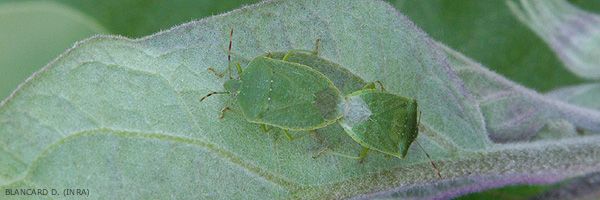
Bedbugs
It should be noted that the species Nesidiocoris tenuis was deliberately introduced into France for biological control purposes to fight against whiteflies and thrips.
- Nature of damage
This stinging-sucking insect, like many other bugs, is likely to cause symptoms mainly on leaves and fruits. We note the wilting of leaves from the apex. On young fruits, the pitting causes tiny punctate spots around which, if cut, the coloration of the underlying tissue is lighter than the rest of the fruit. On ripe fruits, the spots are larger, white to dark yellow (figures 1 and 2). They correspond to the effects of enzymes released during nutritional bites which subsequently diffuse and are at the origin of the white and spongy appearance of deeply degraded tissues which remain firm at maturity ( cloudy spot ) (figure 3). It should be remembered that bedbugs could be vectors of bacteria and yeasts presumed to be responsible for spoilage on fruits once introduced into them.
- Biology
- Forms of conservation and / or alternative hosts : adults overwinter in shelter structures, for example behind the arches of tunnels. This bug parasitizes many plants such as soybeans, rice, various vegetables (eggplant, cucumber, tomato, pepper, beans, etc.), as well as weeds.
- Stages of development : the eggs (figure 4-1), off-white, have the shape of small kegs grouped together in honeycombs on the underside of the leaves. Once the eggs have hatched, dark red to black larvae with white spots (Figure 4-2) gradually disperse on the plants (Figure 1). Five larval stages follow one another, from the neonate larva, which is barely 1 mm long, to the 1 cm long old larva (Figure 4-3), the last instar before the adult (Figure 4-4). The latter measures 1.2 to 1.6 cm long by 0.8 cm wide. It is light green in summer and takes on a purplish brown hue in fall and winter. It has 2 pairs of wings; the first pair, called "hemelytron", is thick and sclerotized in its upper part.
- Dispersion in the culture : mobile larvae and flying adults ensure the dissemination of these insects.
- Favorable development conditions : the limitation of the use of broad-spectrum insecticides, following the development of integrated protection, seems to have contributed to the emergence of these bugs under shelter.
- Protection methods
Several protection methods are recommended to control the development of bugs on tomatoes in France:
- treat the plants before uprooting in the presence of high populations of pests;
- remove and destroy plant debris and crop residues;
- leach with water and treat the walls of shelters , posts, concrete walkways with an insecticide or a contact acaricide ( link e-phy );
- disinfect the equipment used in the greenhouse (drip system, boxes );
- produce the plants in an shelter insect-proof ;
- install canvases insect-proof at shelter openings;
- weed the greenhouse and its surroundings;
- consider chemical protection ( e-phy site ) *, in particular if you use auxiliaries (no auxiliary can be used to control the development of Aculops lycopersici ).
* Chemical control : As the number of pesticides available for a given use is constantly changing, we advise you to always confirm your choice by consulting the e-phy site of the Ministry of Agriculture and Fisheries which is an online catalog of plant protection products and their uses, fertilizers and growing media approved in France. This also applies to all biological products based on microorganisms or natural substances.





